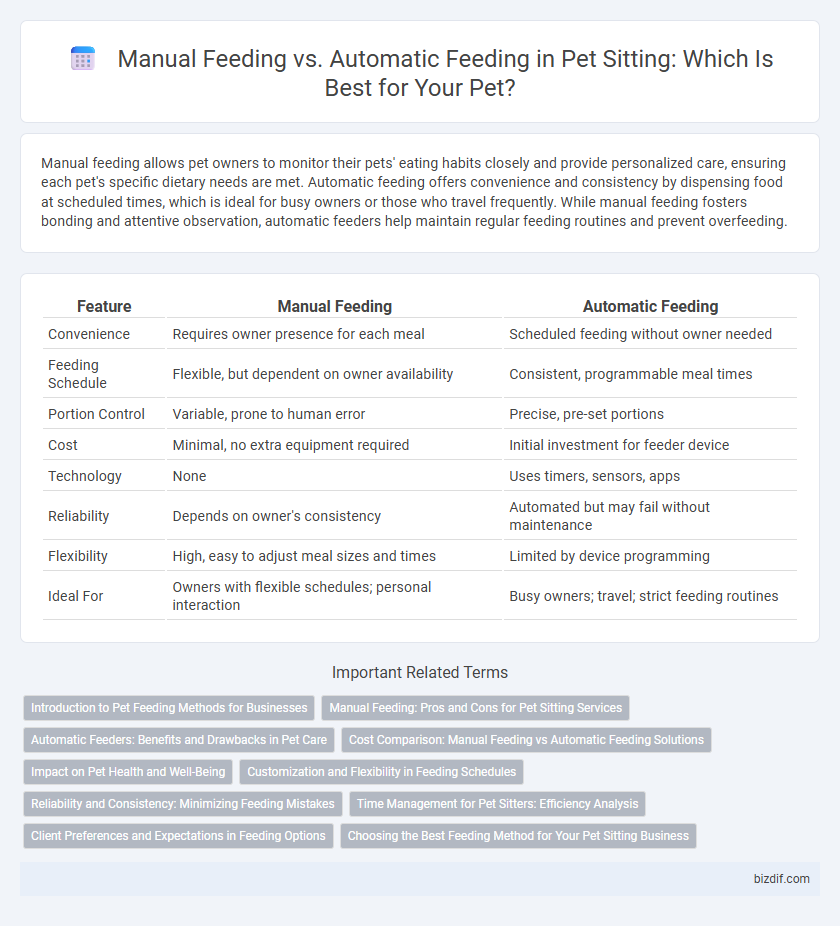Manual feeding allows pet owners to monitor their pets' eating habits closely and provide personalized care, ensuring each pet's specific dietary needs are met. Automatic feeding offers convenience and consistency by dispensing food at scheduled times, which is ideal for busy owners or those who travel frequently. While manual feeding fosters bonding and attentive observation, automatic feeders help maintain regular feeding routines and prevent overfeeding.
Table of Comparison
| Feature | Manual Feeding | Automatic Feeding |
|---|---|---|
| Convenience | Requires owner presence for each meal | Scheduled feeding without owner needed |
| Feeding Schedule | Flexible, but dependent on owner availability | Consistent, programmable meal times |
| Portion Control | Variable, prone to human error | Precise, pre-set portions |
| Cost | Minimal, no extra equipment required | Initial investment for feeder device |
| Technology | None | Uses timers, sensors, apps |
| Reliability | Depends on owner's consistency | Automated but may fail without maintenance |
| Flexibility | High, easy to adjust meal sizes and times | Limited by device programming |
| Ideal For | Owners with flexible schedules; personal interaction | Busy owners; travel; strict feeding routines |
Introduction to Pet Feeding Methods for Businesses
Manual feeding allows pet sitters to closely monitor pets' eating habits, ensuring portion control and addressing individual dietary needs with personalized attention. Automatic feeding systems offer convenience and consistency, dispensing pre-measured meals at scheduled intervals, which is especially beneficial for managing multiple pets simultaneously. Businesses can enhance operational efficiency and improve pet care quality by integrating both feeding methods tailored to specific pet requirements.
Manual Feeding: Pros and Cons for Pet Sitting Services
Manual feeding in pet sitting services allows for personalized attention, ensuring pets receive the right portion and type of food according to their specific dietary needs and preferences. This hands-on approach helps monitor pets' health closely for any sudden changes in appetite or digestion, contributing to responsive and tailored care. However, manual feeding can be time-consuming and inconsistent if the sitter is managing multiple animals, potentially leading to missed meals or overfeeding.
Automatic Feeders: Benefits and Drawbacks in Pet Care
Automatic feeders in pet care offer precise portion control and scheduled feeding times, reducing the risk of overfeeding and enhancing pet health management. These devices promote convenience for pet owners with busy schedules, ensuring pets receive consistent meals even during absences. However, automatic feeders may lack the personalized attention of manual feeding, and technical malfunctions can disrupt feeding routines, potentially impacting pets with specific dietary needs.
Cost Comparison: Manual Feeding vs Automatic Feeding Solutions
Manual pet feeding requires minimal upfront investment but can incur higher long-term labor costs and potential food waste due to inconsistent portion control. Automatic feeders involve a higher initial purchase price ranging from $30 to $200, yet they offer precise portioning and time-saving convenience, which can reduce food costs over time. Evaluating budget constraints and feeding frequency helps determine the most cost-effective feeding method for pet owners.
Impact on Pet Health and Well-Being
Manual feeding allows pet owners to closely monitor portion sizes and adjust meals based on their pet's specific dietary needs, promoting optimal health and preventing overfeeding. Automatic feeders provide consistent meal schedules, aiding pets with routine-based eating habits and reducing stress related to irregular feeding times. However, lack of real-time interaction during automatic feeding may limit early detection of appetite changes or health issues, emphasizing the importance of regular human oversight.
Customization and Flexibility in Feeding Schedules
Manual feeding allows precise customization of portion sizes and feeding times tailored to a pet's unique dietary needs, ensuring optimal nutrition and health management. Automatic feeders offer flexible programming options with multiple meals scheduled throughout the day, providing consistent meal times even during owner absences. Combining manual and automatic feeding methods can enhance adaptability while maintaining strict control over a pet's feeding routine.
Reliability and Consistency: Minimizing Feeding Mistakes
Manual feeding requires close attention to schedule and portion sizes to avoid feeding mistakes, but it depends heavily on caregiver reliability and consistency. Automatic feeders ensure precise timing and measured portions, reducing the risk of overfeeding or missed meals. Both methods can be effective, but automatic feeders often provide greater consistency in maintaining pet health.
Time Management for Pet Sitters: Efficiency Analysis
Manual feeding requires pet sitters to dedicate specific time slots for each feeding session, which can limit the ability to attend to multiple pets efficiently. Automatic feeders help optimize time management by providing consistent meal portions at scheduled intervals without constant human supervision, allowing sitters to allocate time towards other care tasks. Employing automatic feeding systems enhances operational efficiency and reduces the risk of missed or delayed meals in pet sitting routines.
Client Preferences and Expectations in Feeding Options
Clients selecting pet sitting services often prioritize feeding options that align with their pets' dietary routines and specific health needs. Manual feeding allows for personalized portion control and direct observation, meeting expectations for attentive care and flexibility. Automatic feeding appeals to clients seeking consistency and convenience, offering timed meals that accommodate busy schedules while ensuring regular nutrition.
Choosing the Best Feeding Method for Your Pet Sitting Business
Manual feeding allows pet sitters to monitor pets' eating habits closely, ensuring tailored attention to portion sizes and dietary needs, which is crucial for pets with special health conditions. Automatic feeders provide consistent meal timing and portion control, enhancing efficiency and reducing the risk of overfeeding in busy pet sitting schedules. Selecting the best feeding method depends on the specific needs of the pets, client preferences, and the sitter's ability to provide personalized care versus scalable service.
Manual feeding vs automatic feeding Infographic

 bizdif.com
bizdif.com